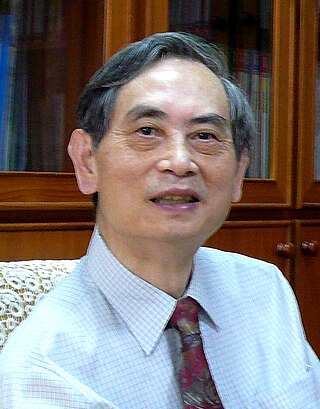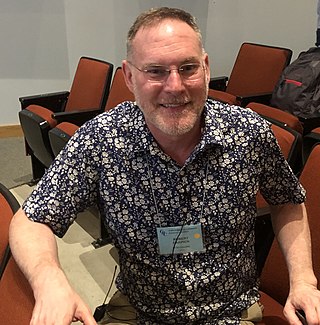Related Research Articles
Sajeev John,OC,FRSC is a Professor of Physics at the University of Toronto and Canada Research Chair holder.

Sumio Iijima is a Japanese physicist and inventor,often cited as the inventor of carbon nanotubes. Although carbon nanotubes had been observed prior to his "invention",Iijima's 1991 paper generated unprecedented interest in the carbon nanostructures and has since fueled intense research in the area of nanotechnology.

The Canadian Light Source (CLS) is Canada's national synchrotron light source facility,located on the grounds of the University of Saskatchewan in Saskatoon,Saskatchewan,Canada. The CLS has a third-generation 2.9 GeV storage ring,and the building occupies a footprint the size of a Canadian football field. It opened in 2004 after a 30-year campaign by the Canadian scientific community to establish a synchrotron radiation facility in Canada. It has expanded both its complement of beamlines and its building in two phases since opening. As a national synchrotron facility with over 1000 individual users,it hosts scientists from all regions of Canada and around 20 other countries. Research at the CLS has ranged from viruses to superconductors to dinosaurs,and it has also been noted for its industrial science and its high school education programs.

Alec Nigel Broers,Baron Broers,is a British electrical engineer.

The McMaster Faculty of Engineering is a faculty located at McMaster University in Hamilton,Ontario. The faculty was established in 1958 and was the first engineering program to developed problem-based learning curriculum. It currently has seven departments in chemical engineering,civil engineering,computing and software,electrical and computer engineering,engineering physics,material science and engineering and mechanical engineering. The faculty offers bachelors,masters,and doctoral degrees.

The Faculty of Science is the largest of six faculties at McMaster University in Hamilton,Ontario,Canada. Founded in 1962,the faculty is located in the Westdale neighbourhood. It houses 6,800 undergraduate students and 600 graduate students,across 39 upper-year undergraduate programs ranging from astrophysics,biochemistry,earth and environmental sciences,to life sciences,human behaviour,kinesiology and medical and radiation sciences. Notable discoveries at McMaster University include the development of neutron spectroscopy by Bertram Brockhouse which earned him a Nobel Prize in Physics in 1994.

Allen Taflove was a full professor in the Department of Electrical and Computer Engineering of Northwestern's McCormick School of Engineering,since 1988. Since 1972,he pioneered basic theoretical approaches,numerical algorithms,and applications of finite-difference time-domain (FDTD) computational solutions of Maxwell's equations. He coined the descriptors "finite difference time domain" and "FDTD" in the 1980 paper,"Application of the finite-difference time-domain method to sinusoidal steady-state electromagnetic penetration problems." In 1990,he was the first person to be named a Fellow of the Institute of Electrical and Electronics Engineers (IEEE) in the FDTD area. Taflove was the recipient of the 2014 IEEE Electromagnetics Award with the following citation:"For contributions to the development and application of finite-difference time-domain (FDTD) solutions of Maxwell's equations across the electromagnetic spectrum." He was a Life Fellow of the IEEE and a Fellow of the Optical Society (OSA). His OSA Fellow citation reads:"For creating the finite-difference time-domain method for the numerical solution of Maxwell's equations,with crucial application to the growth and current state of the field of photonics."

Nader Engheta is an Iranian-American scientist. He has made pioneering contributions to the fields of metamaterials,transformation optics,plasmonic optics,nanophotonics,graphene photonics,nano-materials,nanoscale optics,nano-antennas and miniaturized antennas,physics and reverse-engineering of polarization vision in nature,bio-inspired optical imaging,fractional paradigm in electrodynamics,and electromagnetics and microwaves.

Karen L. Kavanagh is a professor of physics at Simon Fraser University in Burnaby,British Columbia,Canada,where she heads the Kavanagh Lab,a research lab working on semiconductor nanoscience.
Arthur J. Carty,,is a Canadian academic and former National Science Advisor to the Government of Canada.

Roman Grigorievich Maev,is a Canadian professor of physics at the University of Windsor,distinguished university professor,the Foreign Member of the Russian Academy of Sciences (RAS) (2019),full professor in physics (2005),Dr. Sc. (2002),Ph. D. (1973). Dr. Maev is the founding director of the Institute for Diagnostic Imaging Research at the University of Windsor.

Sow-Hsin Chen,was a Hoklo Taiwanese physicist and Professor Emeritus at Massachusetts Institute of Technology (MIT). He was a recognized pioneer in the research of the dynamic properties of supercooled and interfacial water with the use of neutron scattering techniques. As an educator,he was recognized for his training of young scientists in the use of those same techniques. Regarding hydrogen storage,his research focused on the use of activated carbon to allow hydrogen to be stored at room temperature.

David J. Lockwood is a Canadian physicist and researcher emeritus at the National Research Council of Canada (NRC). He is also an adjunct professor at the University of Windsor in Windsor,Ontario,editor of the journal Solid State Communications,editor of the Springer book series "Topics in Applied Physics",and secretary-treasurer of the Canadian Association of Physicists. Lockwood is a Fellow of the Royal Society of Canada,the American Physical Society,the Electrochemical Society,and the Institute of Physics.
Julia Wan-Ping Hsu is an American materials scientist. In her research,she uses scanning probe microscopy to study the nanostructure,optics,and photoelectric properties of thin films and crystal surfaces,with particular application to solar cells,and has used nanotransfer printing to make electrical connections to single-molecule sensing devices. She is a professor of materials science and engineering at the University of Texas at Dallas,where she holds the Texas Instruments Distinguished Chair in Nanoelectronics.

Kasturi Lal Chopra was an Indian materials physicist and a former director of the Indian Institute of Technology,Kharagpur. He was the founder of the Thin Film Laboratory at Indian Institute of Technology,Delhi and the Microscience Laboratory at IIT,Kharagpur and held several US and Indian patents for his research findings. Author of a number of books on thin film technology,he was a recipient of Shanti Swarup Bhatnagar Prize,the highest Indian award in the science and technology categories. The Government of India awarded him the fourth highest civilian honour of the Padma Shri,in 2008,for his contributions to science and engineering.

Donna Theo Strickland is a Canadian optical physicist and pioneer in the field of pulsed lasers. She was awarded the Nobel Prize in Physics in 2018,together with Gérard Mourou,for the practical implementation of chirped pulse amplification. She is a professor at the University of Waterloo in Ontario,Canada.

Hui Cao (曹蕙) is a Chinese American physicist who is the professor of applied physics,a professor of physics and a professor of electrical engineering at Yale University. Her research interests are mesoscopic physics,complex photonic materials and devices,with a focus on non-conventional lasers and their unique applications. She is an elected member of the US National Academy of Sciences and of the American Academy of Arts and Sciences.
Joanne Etheridge is an Australian physicist. She is Director of the Monash Centre for Electron Microscopy and Professor in the Department of Materials Science and Engineering at Monash University.

Robert William Carpick is a Canadian mechanical engineer. He is currently director of diversity,equity,and inclusion and John Henry Towne Professor in the Department of Mechanical Engineering and Applied Mechanics at the University of Pennsylvania. He is best known for his work in tribology,particularly nanotribology.

KatalinBalázsi is a Slovakia-born Hungarian material scientist. She is the head of the Thin Film Physics department in the Institute of Technical Physics and Materials Science,a component of the Centre for Energy Research,Eötvös Lóránd Research Network. She has also served as the President of the Association of Hungarian Women in Science (2018-2021).
References
- ↑ "Botton, Gianluigi, 1963-". VIAF . Retrieved July 20, 2021.
- ↑ "Dr. Gianluigi Botton". McMaster University . Retrieved July 20, 2021.
- 1 2 "2020 Gianluigi Botton". Microscopy Society. Retrieved July 20, 2021.
- 1 2 "Big Ideas: Attention to detail". McMaster University. May 8, 2018. Retrieved July 20, 2021.
- 1 2 "McMaster engineering professor named Fellow of the Royal Society of Canada". McMaster University. September 13, 2018. Retrieved July 20, 2021.
- ↑ "Dr. Botton has been named a fellow of the Microscopy Society of America". Botton's Group. September 26, 2013. Retrieved July 20, 2021.
- ↑ "Dr. Botton advanced to Tier-1 standing". Botton's Group. January 14, 2009. Retrieved July 20, 2021.
- ↑ "Dr. Botton receives 2017 Canadian Materials Science Conference Metal Physics Award". McMaster University. June 6, 2017. Retrieved July 20, 2021.
- ↑ "Dr. Botton receives McMaster University Faculty of Engineering Research Achievement Award". McMaster University. May 12, 2017. Retrieved July 20, 2021.
- ↑ "MICROSCOPY EXPERT JOINS CLS AS SCIENCE DIRECTOR". Canadian Light Source. April 16, 2019. Retrieved July 20, 2021.
- ↑ "New CEO appointed for the UK's national synchrotron, Diamond Light Source". Diamond Light Source. Retrieved August 9, 2023.